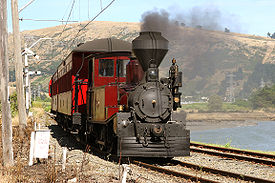
Ferrymead
Encyclopedia
Geography
Ferrymead is located on the Avon Heathcote EstuaryAvon Heathcote Estuary
The Avon Heathcote Estuary is the largest semi-enclosed shallow estuary in Canterbury and remains one of New Zealand’s most important coastal wetlands. It is well known as an internationally important habitat for migratory birds, and it is an important recreational playground and educational resource...
, close to the point where the Heathcote River
Heathcote River
The Heathcote River lies within the city boundaries of Christchurch, New Zealand, and is fed from springs near Templetons Road and also receives wet weather flows from as far west as Pound Road. It meanders around the base of the Port Hills from west to south-east.-Course:The catchment of the...
drains into the estuary, and three km west of the eventual outflow into Pegasus Bay
Pegasus Bay
Pegasus Bay is on the east coast of the South Island of New Zealand.-Location:The bay has a sandy beach and runs from Banks Peninsula to the Waipara River mouth...
. To the north lie the oxidation ponds from Christchurch's main sewage treatment works, which are within a large wildlife refuge and are inhabited by many species of bird life. To the south lie the Port Hills
Port Hills
The Port Hills form the northern rim of the ancient Lyttelton volcano, separating the port of Lyttelton from the city of Christchurch in Canterbury, New Zealand...
. The suburb is named for the ferry that operated across the Heathcote River during the early period of settlement.
Early European settlement
European settlement of the area dates from the arrival of the early colonists in 1850. Farming was the major industry of the area from its early years and parts of the Heathcote Valley are still in agricultural production. Ferry services began about 1851 firstly as a cattle punt. These continued until the completion of the Heathcote Bridge in 1864. Shipping at this time was also able to travel up the Heathcote River as far as the Christchurch Quay adjacent to the present Radley Street Bridge. Later the Steam Wharf was opened by the present Tunnel Road intersection with Ferry Road. The Railway Wharf was opened in December 1863 along with the Ferrymead Railway.Shipping on the river was very costly, around 2 pounds per tonne, more than it cost to bring cargo from the UK, and the ships were very small. Later on, steamships brought the cost down, but the difficulties of bringing ships over the bar of the Estuary and up the river itself were a considerable inconvenience. River shipping only outlasted the advent of the railway by a few years, although both the 1864 and 1907 bridges were designed to allow shipping to pass.

The original railway
On 1 December 1863 New Zealand's first public railway line was opened from Ferrymead to the central city.The line was a temporary expedient to allow construction of the Heathcote/Lyttelton tunnel to proceed. It closed in 1867 after the opening of the Moorhouse railway tunnel to the port of Lyttelton
Lyttelton, New Zealand
Lyttelton is a port town on the north shore of Lyttelton Harbour close to Banks Peninsula, a suburb of Christchurch on the eastern coast of the South Island of New Zealand....
.
Its track ran 7 km to the city of Christchurch, where the station was situated near to the site later occupied by the 1960 Christchurch station (closed in 1995). The locomotives and rolling stock were imported from Victoria, Australia, this being the main reason why the 5' 3" (1600 mm) railway gauge was adopted. Stations were located in later years at Woolston (formerly Hillsborough), Opawa and Linwood (the last two as passenger halts until the end of suburban trains in 1972). A branch also headed towards Heathcote at the time of tunnel construction.
The Moorhouse Tunnel was completed in a much shorter time than envisaged; and consequently the Ferrymead Railway was officially closed on 9 November 1867, the same day as the railway line to Lyttelton was opened. Following the subsequent conversion of the Main South Line to 3' 6" (1067 mm) gauge, all its broad gauge rolling stock was sold back to Australia. Unfortunately the ship they were placed on was wrecked off the NZ coast, but it is believed the cargo was salvaged. The formation then lay abandoned for almost 100 years until the advent of Ferrymead Historic Park.
Following the commemoration of the centenary of this line, various groups including the New Zealand Railway and Locomotive Society
New Zealand Railway and Locomotive Society
The New Zealand Railway and Locomotive Society Inc is a society of railway enthusiasts, based in Wellington.The Society publishes a magazine, the New Zealand Railway Observer and a newsletter Turntable. The Society publishes books on railway subjects. There are currently about 25 books available,...
(Canterbury Branch) (now the Canterbury Railway Society
Canterbury Railway Society
The Canterbury Railway Society is an organisation of railway enthusiasts based in the Canterbury region of New Zealand's South Island.-Beginnings:...
) became interested in developing the historical site. The Ferrymead Railway
Ferrymead Railway
The Ferrymead Railway is a New Zealand heritage railway built upon the formation of New Zealand's first public railway, the line from Ferrymead to Christchurch, which opened in 1863. On the opening of the line to Lyttelton on 9 December 1867, the Ferrymead Railway became the Ferrymead Branch and...
operates on the original railway formation as part of Ferrymead Heritage Park
Ferrymead Heritage Park
Ferrymead Heritage Park is a museum in Christchurch, New Zealand, housing a number of groups with historical themes, the most frequent of which is transport. Formerly known as Ferrymead Historic Park, it was founded in the mid-1960s by a number of groups, local government bodies and other...
(formerly Ferrymead Historic Park).
See also
- Ferrymead Heritage ParkFerrymead Heritage ParkFerrymead Heritage Park is a museum in Christchurch, New Zealand, housing a number of groups with historical themes, the most frequent of which is transport. Formerly known as Ferrymead Historic Park, it was founded in the mid-1960s by a number of groups, local government bodies and other...
- Plan of original Ferrymead Station

